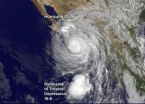(Press-News.org) Cognitive neuroscience research has shown that certain brain regions are associated with specific cognitive abilities, such as language, naming, and decision-making.
How and where these specific abilities are integrated in the brain to support complex cognition is still under investigation. However, researchers at the University of Iowa and Washington University in St. Louis, Missouri, believe that several hub regions may be especially important for the brain to function as an integrated network.
In research published online Sept. 15 in the Early Edition of the Proceedings of the National Academy of Sciences, scientists studied neurological patients with focal brain damage, and found that damage to six hub locations—identified in a model developed at Washington University using resting state fMRI, functional connectivity analyses, and graph theory—produced much greater cognitive impairment than damage to other locations.
Doctors have long observed that despite having similar locations or extent of brain injury, patients often present with wide-ranging degrees of impairment and exhibit different recovery trajectories. A better understanding of brain networks and hubs may improve the understanding of outcomes of brain injuries (for example, stroke, resection, or trauma) and help inform prognosis and rehabilitation efforts.
"We were able to identify a set of brain hubs and show that damage to those locations unexpectedly causes widespread cognitive impairments," says David Warren, cognitive neuroscientist at the University of Iowa and lead study author. "We hope that this framework will help neurologists with diagnosis and prognosis, and neurosurgeons with surgical planning."
Two contrasting views of brain hubs exist. One view focuses on the sheer number of connections between brain regions, with those regions showing the most connections considered hubs.
Warren and his colleagues contend that the number of connections a given region makes may not reflect the importance of a region to network function because it can be strongly influenced by network size. Instead, their framework defines hubs as brain regions that show correlated activity with multiple brain systems (rather than regions). The authors predicted that because hubs should be critical for brain function and complex cognition, damage to true hubs should produce widespread cognitive impairment.
This study evaluated long-term cognitive and behavioral data in 30 patients in the Iowa Neurological Patient Registry—19 with focal damage to one of the authors' six target hub locations and 11 with damage to two control locations that fit the alternative hub definition.
On average, patients with lesions to target hubs had significant impairment in nine major cognitive domains—orientation/attention, perception, memory, language skills, motor performance, concept formation/reasoning, executive functions, emotional functions, and adaptive functions. In contrast, the group with lesions to control hubs was significantly impaired in just three of the nine domains (executive functions, emotional functions, and adaptive functions).
Additionally, the target group had significantly greater cognitive deficits than the control group in seven of nine domains (all except perception and emotional functions), again showing the widespread cognitive effects of target hub lesions.
"With a grant from the McDonnell Foundation, we're planning to follow up by exploring the effects of damage to additional brain hubs, examining how damage to hubs alters brain activation, and studying neurosurgery patients prospectively before and after their surgeries," says senior study author Daniel Tranel, professor of neurology in the UI Carver College of Medicine and psychology in the College of Liberal Arts and Sciences. "We think that this work could have a tremendous influence on clinical practice."
INFORMATION:
In addition to Tranel and Warren, the research team included Joel Bruss, Natalie Denburg, and Eric Waldron from the UI Department of Neurology; and Steven Petersen, Jonathan Power, and Haoxin Sun from the Washington University Department of Neurology.
The research was funded by the National Institutes of Health grants (number: PO1 NS19632, number: R21NS061144, number: F30 MH940322), McDonnell Foundation Collaborative Action Awards, Simons Foundation Award (number: 95177), and National Institutes of Mental Health Grant (number: R01 MH062500).
Network measures predict neuropsychological outcome after brain injury
2014-09-15
ELSE PRESS RELEASES FROM THIS DATE:
Cells simply avoid chromosome confusion
2014-09-15
Reproductive cell division has evolved a simple, mechanical solution to avoid chromosome sorting errors, researchers report in the Sept. 11 Science Express.
This natural safeguard prevents incorrect chromosome counts and misalignments that lead to infertility, miscarriage, or congenital conditions.
"Mistakes during reproductive cell division cause these problems, but what exactly goes wrong is often not understood," said Adele Marston of the Wellcome Trust Center for Cell Biology at the University of Edinburgh in Scotland and lead author of the study. Understanding ...
NASA's TRMM satellite sees Hurricane Odile strike Baja California
2014-09-15
VIDEO:
This animation of NOAA's GOES-West satellite imagery from Sept. 13 through Sept. 15 shows Hurricane Odile's movement and landfall near Cabo San Lucas on Mexico's Baja California. TRT 0:42...
Click here for more information.
NASA's Tropical Rainfall Measuring Mission satellite known as TRMM captured data on powerful Hurricane Odile revealing heavy rainfall from powerful thunderstorms as it made landfall in Baja California. Odile tied a record for strongest hurricane to hit ...
IU study: Combining epilepsy drug, morphine can result in less pain, lower opioid doses
2014-09-15
INDIANAPOLIS -- Adding a common epilepsy drug to a morphine regimen can result in better pain control with fewer side effects. Moreover, the combination can reduce the dosage of the opioid needed to be effective, according to a team of pain researchers at Indiana University.
The result could bring significant relief to many patients with neuropathic pain, a difficult-to-treat condition often felt in the arms and legs and associated with nerve tissue damage.
"There is a huge unmet need for better treatments for neuropathic pain," said Fletcher A. White, Ph.D., the Vergil ...
'Squid skin' metamaterials project yields vivid color display
2014-09-15
The quest to create artificial "squid skin" -- camouflaging metamaterials that can "see" colors and automatically blend into the background -- is one step closer to reality, thanks to a breakthrough color-display technology unveiled this week by Rice University's Laboratory for Nanophotonics (LANP).
The new full-color display technology uses aluminum nanoparticles to create the vivid red, blue and green hues found in today's top-of-the-line LCD televisions and monitors. The technology is described in a new study that will be posted online this week in the Early Edition ...
Researchers discover new producer of crucial vitamin
2014-09-15
New research has determined that a single group of microorganisms may be responsible for much of the world's vitamin B12 production in the oceans, with implications for the global carbon cycle and climate change.
Although vitamin B12 is an essential molecule required by most life on this planet, it is only produced by a relatively small group of microorganisms because it is so large and complex. For humans, vitamin B12 plays a key role in maintaining the brain and nervous systems, as well as DNA synthesis in cells throughout the body.
Professors Andew Doxey and Josh ...
X-rays unlock a protein's SWEET side
2014-09-15
Sugar is a vital source of energy for both plants and animals alike.
Understanding just how sugar makes its way into the cell could lead to the design of better drugs for diabetes patients and an increase in the amount of fruits and vegetables farmers are able to grow. Stanford University researchers have recently uncovered one of these "pathways" into the cell by piecing together proteins slightly wider than the diameter of a strand of spider silk.
To determine the size, shape and orientation of one of the newest (and smallest) of these proteins, the sugar transporter, ...
Pitt chemical biologist finds new halogenation enzyme
2014-09-15
PITTSBURGH—Molecules containing carbon-halogen bonds are produced naturally across all kingdoms of life and constitute a large family of natural products with a broad range of biological activities. The presence of halogen substituents in many bioactive compounds has a profound influence on their molecular properties.
One of the Holy Grails in chemical science has been to find the late-stage, site-specific incorporation of a halogen atom into a complex natural product by replacing an sp³ C-H bond (one of the most inert chemical bonds known in an organic compound) with ...
Satellite sees Tropical Depression 16-E remnants scooped by Hurricane Odile
2014-09-15
At 11 p.m. EDT on Sunday, September 14, Tropical Depression 16-E was officially a remnant low pressure area. NOAA's GOES-West satellite showed the clouds associated with the remnants being drawn into the massive circulation of nearby Hurricane Odile.
At 5 a.m. on Sunday, September 14, Tropical Depression 16-E (TD 16-E) was still holding together despite being close to the circulation of Hurricane Odile. At that time, the center of tropical depression 16-E was located near latitude 14.9 north and longitude 115.3 west. That's about 655 miles (1,055 km) south-southwest ...
Satellites show Edouard's transition into an Atlantic Hurricane
2014-09-15
VIDEO:
This GOES-East satellite image animation of Edouard from Sept. 13 through 15 showed the storm consolidating. The eye of the hurricane became visible on and off during Sept. 14 in...
Click here for more information.
NASA's Terra satellite passed over Tropical Storm Edouard each day from September 12 through 14 and captured imagery of the storm as it grew into a hurricane. NOAA's GOES-East satellite covers the Atlantic Ocean and takes visible images during the day and infrared ...
NASA sees Typhoon Kalmaegi as a whirlpool of clouds in the South China Sea
2014-09-15
NASA's Aqua satellite observed Typhoon Kalmaegi crossing the South China Sea and a satellite image from the MODIS instrument aboard made it look like a whirlpool of clouds.
On Sunday, September 14, Kalmaegi passed over northern Luzon, Philippines and emerged into the South China Sea. Typhoon Kalmaegi's maximum sustained winds were near 65 knots (75 mph) making it a category one hurricane on the Saffir-Simpson scale as it moved over the Philippines.
On September 15 at 05:15 UTC (1:15 a.m. EDT) the Moderate Resolution Imaging Spectroradiometer aboard NASA's Aqua satellite ...





